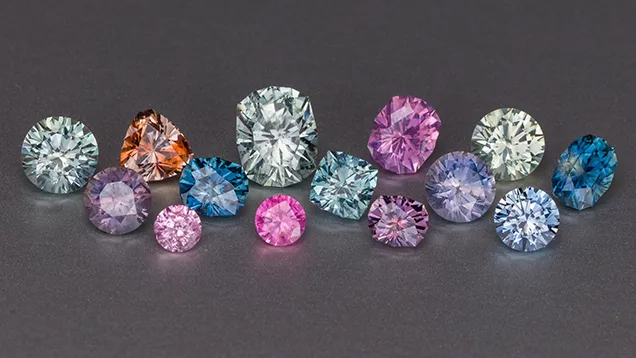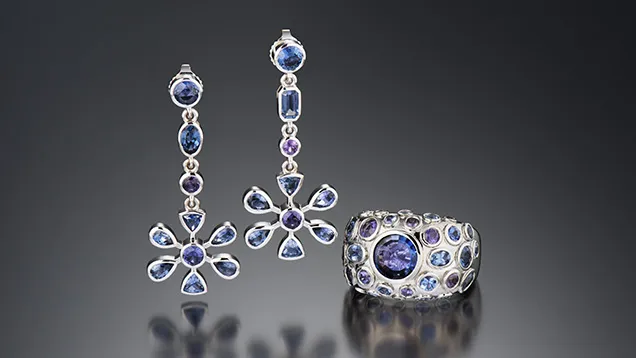Montana, a state in the Western United States, is renowned not only for its majestic natural landscapes but also as one of the nation’s few gemstone-rich regions. Since the late 19th century, Montana’s mineral extraction history has been closely linked to gold, silver, and copper. During the gold rush era, another treasure was unearthed – Montana sapphires, captivating gemstones with unique beauty and a fascinating historical narrative. This article will guide you on a journey to explore Montana’s most famous sapphire mining locations, where these precious stones were excavated and have enchanted enthusiasts worldwide.
The History of Montana Sapphire Mining
The history of sapphire mining in Montana began in the latter half of the 19th century when gold miners discovered corundum, a mineral containing sapphire, while prospecting for gold in southwestern Montana. This event marked a new chapter in the state’s mineral extraction history, with sapphire quickly becoming a valuable resource alongside gold, silver, and copper.
Sapphires have been found in four primary regions of Montana, each with its own historical significance and distinct characteristics:
- Upper Missouri River (1865): The first sapphires were discovered in placer deposits along the upper Missouri River, marking the beginning of Montana’s sapphire mining industry.
- Dry Cottonwood Creek (1889): Subsequently, sapphires were found at Dry Cottonwood Creek, also a placer deposit, further expanding the mining area.
- Rock Creek / Gem Mountain (1892): Rock Creek, also known as Gem Mountain, became the most significant placer deposit mine, boasting the largest historical production.
- Yogo Gulch (1895): Yogo Gulch stands out as the only primary deposit mine, where sapphires are found directly in the bedrock, unlike other placer mines.

Location of Montana sapphire mines – Source: GIA
Yogo sapphires, mined from Yogo Gulch, are famed for their exquisite cornflower blue to lilac hues, high clarity, and consistent color saturation. However, their small size is a limitation, rarely reaching world-class dimensions. Despite this, Yogo sapphires are highly esteemed and valued in the US market.
Sapphires from placer mines like Rock Creek, Missouri River, and Dry Cottonwood Creek offer a wider color range, including unique “fancy colors” and grayish blue shades. Notably, Bicolor sapphires, displaying a blend of two colors within a single stone, are a distinctive feature of Rock Creek sapphires.
In the early days, Montana sapphires were primarily mined to serve the watchmaking industry, particularly supplying natural sapphire bearings for watch movements. However, the development of synthetic sapphires significantly diminished the demand for natural sapphires for industrial purposes. Today, Montana sapphires are primarily mined for jewelry and tourism.
Missouri River Mine – The Birthplace of Montana Sapphires
The Missouri River Mine, located along the upper Missouri River, is where sapphires were first discovered in Montana in 1865. Gold miners found sapphire crystals in the river gravels, approximately 24 km northeast of Helena.
Ed R. Collins, a pioneer in gemstone mining, recognized the potential of these sapphires and sent them to New York for cutting by renowned gem cutters such as Tiffany & Co. and M. Fox & Co., as well as workshops overseas.
In 1873, Dr. J. Lawrence Smith, a respected mineralogist, studied and confirmed that the sapphires from the Missouri River were a high-quality source of corundum, superior to any other source in the United States at the time.
During World War II, the Eldorado Bar mine in the Missouri River area played a crucial role. Although President Roosevelt ordered the closure of gold mines in 1942 to focus resources on the war effort, the Perry-Schroeder Mining Company was permitted to continue dredging for gold at Eldorado Bar. This was because sapphire, a significant byproduct of gold mining there, had essential military applications in bombs, torpedoes, and grinding wheels. From 1940 to 1944, the Perry-Schroeder gold dredge recovered approximately 7 million carats of sapphires from Eldorado Bar, mostly for industrial use.

Eldorado Bar Mine – Source: GIA
Historically, at least 9 sapphire mines were operated along the Missouri River, including American Bar, Eldorado Bar, Dana’s Bar, McCune Bar, Metropolitan Bar, Spokane Bar, French Bar, Gruell’s Bar, and Emerald Bar. All of these mines extracted both gold and sapphires.
Today, some mines like Eldorado Bar and Spokane Bar are still active, mainly catering to tourists and gem enthusiasts. Rough sapphires from the Missouri River area are sold to jewelers, gem dealers, and hobbyist gem cutters.

Sapphire-bearing gravel at Missouri River – Source: GIA
Sapphires from the Eldorado Bar mine often exhibit a distinctive pastel hue, particularly greenish-blue and bluish-green. Pink, purple, yellow, dark green, and ruby colors are also found in this area, but in smaller quantities. Occasionally, large sapphires are discovered, with some weighing nearly 50 carats.
To enhance clarity and color, many Missouri River sapphires undergo heat treatment. However, a significant number are still sold in their natural state, preserving their original beauty.

Heat-treated Missouri River sapphires – Source: GIA
Rock Creek Mine – Montana’s “Gem Mountain”
Rock Creek Mine, also known as Gem Mountain, is the largest placer sapphire mine in Montana and the only area that maintained continuous mining operations from 1892 to World War II.
In 1901, the American Gem Mining Syndicate was established in Philipsburg, with the primary goal of mining and commercializing sapphires from Rock Creek Mine. The majority of rough sapphires from this mine were shipped to Geneva, Switzerland, for cutting and supply to the Swiss watch industry.
Large-scale mining at Rock Creek took place from 1906 to 1923. Mining activities continued for a short period before World War II but later declined due to the advent of synthetic sapphires.
Today, Rock Creek sapphires are primarily mined for the jewelry and tourism industries. However, recent installations of large-scale mechanized mining and processing facilities have marked a resurgence of large-scale sapphire mining in this area.

Rock Creek Mine Map – Source: GIA
Rock Creek Mine is renowned for its high production volume, but most sapphires from here require heat treatment to improve their color.

Mining operations at Rock Creek Mine – Source: GIA
Rock Creek sapphires are distinguished by their diverse and unique colors, especially Bicolor sapphires with color combinations like yellow/green, yellow/pale blue, orange/blue, or different shades of yellow. The “Helena Oval” cut, named after Montana’s capital, is also a characteristic of Rock Creek sapphires.

Montana fancy color sapphires
Montana fancy color sapphires – Source: GIA
Gem Mountain Sapphire Mine, a mining company at Rock Creek, has developed a diversified business model, combining mining, processing, tourism, and jewelry retail. Visitors can experience sapphire panning at the mine’s gravel washing area, creating a unique and engaging tourism offering.

Visitors of all ages searching for gemstones at Gem Mountain.
Tourists panning for sapphires at Gem Mountain – Source: GIA
Yogo Gulch Mine – The Unique Blue “Cornflower” Sapphire
Yogo Gulch Mine, discovered in 1895, is Montana’s only primary deposit sapphire mine. This means that Yogo sapphires are mined directly from the bedrock, rather than from placer deposits like other mines. Yogo Gulch is considered one of the most significant gemstone deposits in the United States.
Jake Hoover, a gold prospector, accidentally discovered bright blue stones at Yogo Gulch. He sent these stones to Dr. George Kunz of Tiffany & Co. in New York, and they were identified as sapphires. Hoover, along with SS Hobson and Jim Bouvet, partnered to mine sapphires in this area.

Yogo Gulch Mine – Source: GIA
Yogo sapphires are famous for their intense, consistent blue color, sometimes with a lilac tint, high clarity, and lack of color zoning. A particular advantage of Yogo sapphires is that they do not require heat treatment to achieve their best color and clarity.

Rough and cut sapphires, blue to violet or purple, Yogo Gulch mine, Montana, USA.
Rough and cut Yogo sapphires – Source: GIA
However, small size is an inherent characteristic of Yogo sapphires. Most crystals are flat and rarely yield gemstones over 1 carat. Stones of 2 carats or larger are extremely rare. Despite this, Yogo sapphires are highly valuable, especially in the US market, where they are more appreciated than in the global market.
The Yogo Gulch mine is estimated to have produced 18.2 million carats of rough sapphires and over 500,000 carats of cut sapphires. Although mined for over a century, Yogo Gulch is still believed to hold significant reserves.

Yogo blue sapphire jewelry
Yogo sapphire jewelry – Source: GIA
Conclusion
Montana’s historic sapphire mines are not only sources of precious gemstones but also unique cultural and historical legacies of the state. From the placer mines along the Missouri River and Rock Creek to the primary deposit of Yogo Gulch, each location carries stories of mining history, distinctive gemstones, and contributions to the development of the US mineral and gemstone industry. Exploring these sapphire mines is not just a journey of discovering gemstones but also an opportunity to uncover the natural beauty, history, and distinctive culture of Montana, in the Western United States.